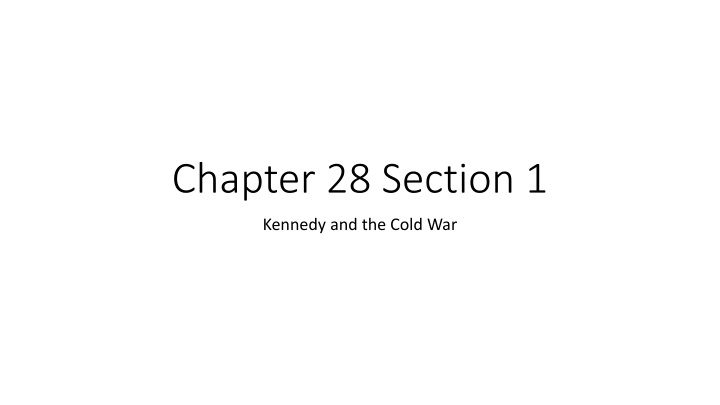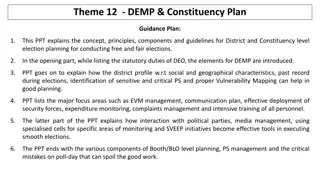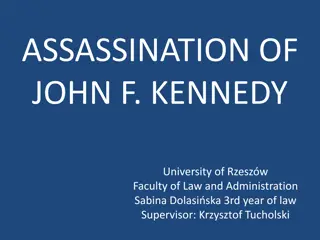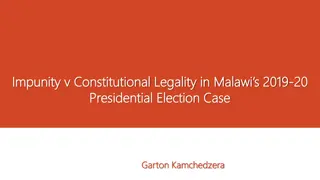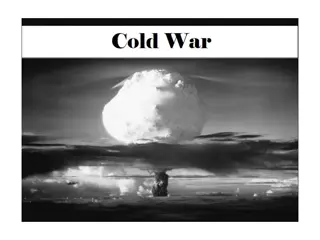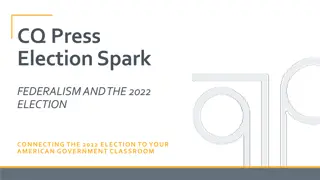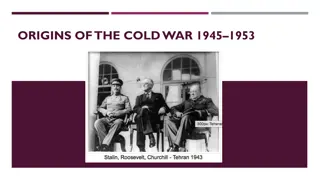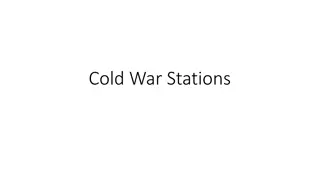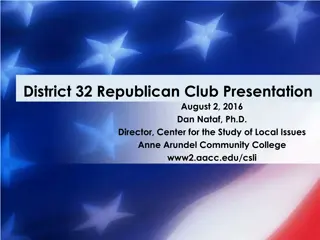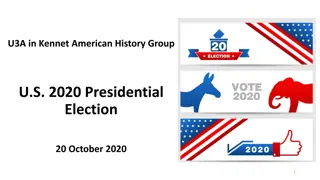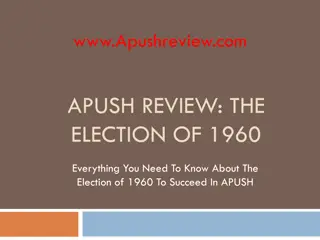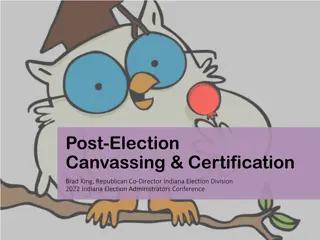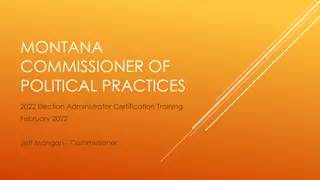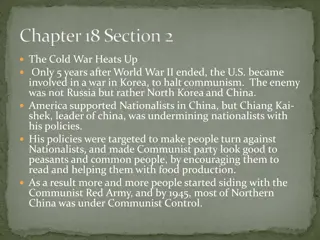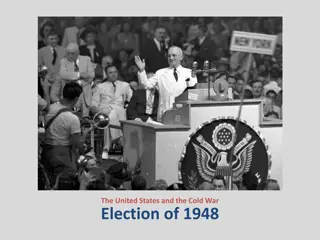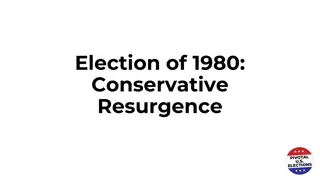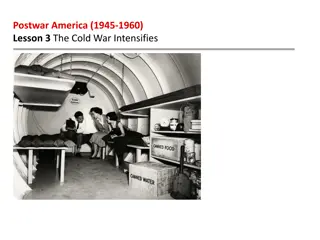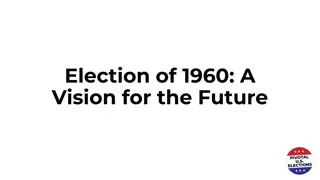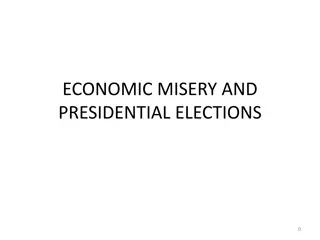Kennedy and the Cold War: A Presidential Election and New Strategies
Kennedy's victory over Nixon in the 1960 presidential election paved the way for new Cold War strategies. Despite differences in upbringing, Kennedy's televised debate win and swift actions during unexpected events secured his narrow victory. With a focus on enhancing the nation's armed forces, Kennedy aimed to address perceived weaknesses in America's Cold War position.
Download Presentation

Please find below an Image/Link to download the presentation.
The content on the website is provided AS IS for your information and personal use only. It may not be sold, licensed, or shared on other websites without obtaining consent from the author.If you encounter any issues during the download, it is possible that the publisher has removed the file from their server.
You are allowed to download the files provided on this website for personal or commercial use, subject to the condition that they are used lawfully. All files are the property of their respective owners.
The content on the website is provided AS IS for your information and personal use only. It may not be sold, licensed, or shared on other websites without obtaining consent from the author.
E N D
Presentation Transcript
Chapter 28 Section 1 Kennedy and the Cold War
Kennedy Defeats Nixon in 1960 For eight years, President Dwight Eisenhower had presided over a nation that had generally enjoyed peace and prosperity. Still a number of issues caused Americans concerns.
The Candidates JFK democrat Richard Nixon- Republican First time in history candidates had both been born in 20thentury Both served in navy Elected to congress and senate Both passionate about foreign affairs
Differences: Kennedy was the son of a wealthy businessman Grandfather had been a state senator Father served as ambassador to Great Britain Attended Harvard Nixon Born in Ca. did not enjoy advantages of a wealthy upbringing. Father struggled to make living As a child had to work and go to school V.P under Eisenhower
Televised Debates Make the Difference 1960 election highlighted the growing power and influence of t.v. 4 televised debates Boiled down to how the candidates looked and spoke rather than what they said. Most people thought Nixon had won from the radio but larger audience on tv concluded Kennedy was the victor. Kennedys victory in the Chicago debate proved critical in the election.
Kennedy Wins a Close Election Reacted quickly to unexpected events Ex) several weeks before the election civil rights leader Martin Luther King Jr. and a group of A.A. students were imprisoned during a protest in Ga. Kennedy telephoned Kings wife to express concern, Nixon did not. Kennedy worked behind the scenes to obtain Kings release on bail. Kennedys actions attracted support from A.A. Kennedy won by less than 120,000 of the 68 million popular vote cast.
Kennedy Launches New Cold War Strategies Kennedy argued that during Eisenhower years America had lost ground in the Cold War struggle against communism. Pointed to the new communist regime under Fidel Castro in Cuba and charged that there was now a missile gap that left the U.S. nuclear missile force inferior to that of the Soviet Union. Kennedys first goal was to build up the nations armed forces.
Building the Nations Military Eisenhower's defense policy of massive retaliation had emphasized the construction of nuclear weapons. Kennedy wanted to make sure the U.S was prepared to fight both conventional wars and conflicts against guerilla forces. Increased funding to conventional U.S. army and navy forces and Army Special Forces. Flexible response defense policy was a defense strategy implemented by John F. Kennedy in 1961 to address the Kennedy administration's skepticism of Dwight Eisenhower's New Look and its policy of massive retaliation. calls for mutual deterrence at strategic, tactical, and conventional levels, giving the United States the capability to respond to aggression across the spectrum of warfare, not limited only to nuclear arms.
Pursuing New Initiatives in the Third World Third World: developing nations in Africa, Asia, and Latin America that did not align with the United States or the Soviet Union. Kennedy believed democracy combined with prosperity would contain or limit the spread of communism. Initiated programs to economically an politically strengthen the third world. Peace Corps and the Alliance Progress which generated good will around the world Peace Corps: sent American volunteers around the world on a mission of freedom to assist developing countries Alliance for Progress promised to resurrect Americas Good Neighbor policy toward Latin America. Promoted Economic assistance to Latin America.
Confronting Communism in Cuba U.S. tried to cultivate good relations with Castro but it was clear that the Cuban leader was determined to nationalize land held by private U.S. citizens, enforce radical measures and accept Soviet economic and military aid. Cubans fled the country to Miami and Southern Florida.
Bay of Pigs Invasion Fidel Castro helped to lead the Cuban Revolution in overthrowing the existing government of Cuba in 1959. He was an ardent communist and was allied with the Soviet Union. This deeply concerned the United States as this gave communism and the Soviet Union a foothold in the Americas. The CIA, or Central Intelligence Agency, was tasked with overthrowing Fidel Castro's government in Cuba. There were many people from Cuba, called exiles, who had fled the country when Fidel Castro had become leader. The CIA began to train these exiles in guerrilla warfare. The idea was that they would sneak back into Cuba and begin a guerrilla war against Castro. They would gather others and eventually overthrow Castro.
The plan changed, however. The new plan was help the exiles to invade the island. The hope was that locals would join forces with them and they would quickly take over. In 1961 the United States sent trained Cuban exiles to Cuba to try and overthrow Fidel Castro's government. They failed miserably. The invasion is considered part of the Cold War because the United States was trying to prevent communism from taking hold in the Americas.
The invasion was originally planned to occur at the city of Trinidad, but President Kennedy thought that they needed a more secluded place. The Bay of Pigs was chosen instead. The idea was that planes would fly in first and destroy the air force. Then the invasion force of 1500 soldiers would land. They hoped that the Cuban people would join them in rebelling against Castro. The CIA tried to plan the invasion in secret, however, too many people knew and word got out. The Cubans knew the invasion was coming. The results were disastrous for the United States. The government looked weak and the CIA inept. It also seemed to strengthen Castro's government within Cuba and caused him to look to the Soviet Union as a military ally.
The Cuban Missile Crisis The Cuban Missile Crisis occurred in 1962 when the Soviet Union began to install nuclear missiles in Cuba. The United States refused to allow this and, after thirteen tense days and many secret negotiations, the Soviet Union agreed to remove the missiles. This is perhaps the closest that the United States and the Soviet Union came to nuclear war during the Cold war Kennedy blamed Nikita Khrushchev, the soviet premier for causing a reckless and provocative threat to world peace . Kennedy announced his plan on October 22, 1962. He showed the world the missile bases and said that the United States would be putting Cuba under "quarantine". This meant that no offensive weapons would be allowed to enter Cuba. He also said that any attack on the US from Cuba would be considered an act of war from the Soviet Union. Over the next several days the crisis became more intense. The Soviet Union said they would not back down. By the 24th, Kennedy believed the US would have to invade Cuba.
Although the Soviet Union was publicly saying they would never back down, they were secretly negotiating with the United States. Eventually the two sides reached an agreement. The Soviet Union would remove the missiles from Cuba as long as the United States agreed to never invade Cuba again. In secret, the US also had to agree to remove their nuclear missiles from Turkey and Italy. The crisis was over.
The Result of the Crisis D tente: the easing of hostility or strained relations, especially between countries They installed a hot line telephone system between Moscow and D.C. to improve communication. Nuclear Test Ban Treaty: formally the Treaty Banning Nuclear Weapons Tests in the Atmosphere, in Outer Space, and Under Water, treaty signed in Moscow on August 5, 1963, by the United States, the Soviet Union, and the United Kingdom that banned all tests of nuclear weapons except those conducted underground.
The Berlin Crisis Berlin crisis of 1961, Cold War conflict between the Soviet Union and the United States concerning the status of the divided German city of Berlin. It culminated in the construction of the Berlin Wall in August 1961. The official purpose of this Berlin Wall was to keep Western fascists from entering East Germany and undermining the socialist state, but it primarily served the objective of stemming mass defections from East to West. The Berlin Wall stood until November 9, 1989, when the head of the East German Communist Party announced that citizens of the GDR could cross the border whenever they pleased. That night, ecstatic crowds swarmed the wall. Some crossed freely into West Berlin, while others brought hammers and picks and began to chip away at the wall itself. To this day, the Berlin Wall remains one of the most powerful and enduring symbols of the Cold War.
